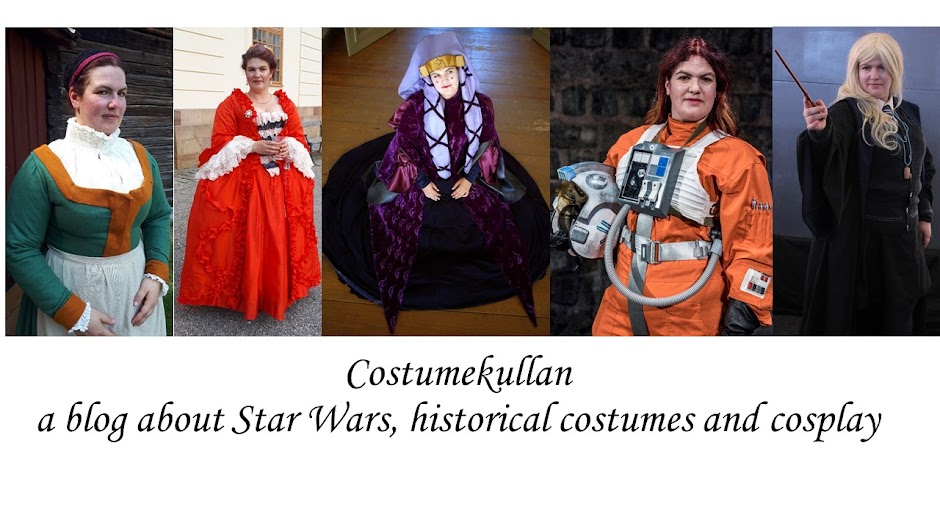I had one challenge left to finish for HSM 2020 to make all 12, and fittingly enough I finished it on the morning of New Year's Eve. So that means I have done all 12 challenges this year, and this is the second time since the HSF/HSM started that I have managed that. Anyway, on the finished result.
November: Go Green Glow-Up: Be environmentally friendly and celebrate how your making skills have ‘glowed-up’ as you’ve used and practiced them by taking apart an early make of yours that no-longer represents your making skills, and re-making it so you’d be proud to use it. It can be as elaborate as a total re-make, or as simple as getting the ribbons or buttons you didn’t have time to source at first. You could even take something from a challenge made earlier in the year, and fix the tiny things you weren’t totally happy with.
I decided to redo my high-necked 1520's shift. That was made as challenge 2 in the HSM2018.
This wasn't my first attempt at 16th century, but it was my first attempt after I had decided to do it seriously. At the time I did not like blackwork, so instead I made a freehand smocking pattern using white wool yarn at the neck. For the cuffs I made just a single row of honeycomb smocking.
Now almost three years later I have found a new appreciation for blackwork and I decided to redo the shift with proper embroideries. Something I have also realised since I made the shift is that the collar is quite commonly made as a separate piece, instead of gathering the full width of the fabric into the neck opening. I couldn't do that, but I decided to do the new embroidery as separate pieces that I then added above the gathered fabric. I have a post about just the
embroidery here. With links to the pattern that I used, both the neck and cuff embroidery is from a patternbook published 1527-1529.
Then it was on to replacing the old embroidery and smocking with the new bands.
This was the old single row of honeycomb smocking, The smocking had not been enough to keep the cuff tight, so it had loosened a lot with use. For the cuffs I simply removed the smocking and redid the gathering threads as well. Nowadays I freehand the gathering so it doesn't take as long as when I did this originally and meticulously measured and made dots where I should put all the gathering stitches.
The remake also allowed me to make the "ruffle" below the cuff longer. I sewed the cuff on over the last row of gathering stitches. I tried to sew so that I attached every ridge of the gathered fabric to the cuff. On the inside I added a linen strip and sewed it on the same way. The original shift had just been pulled over the hands, now I needed a closure. On the Sture shirts from the 1560s there is a buttonhole on the cuff, but no button remains.
I made a buttonhole on the inner linen strip, and then I made a narrow linen ribbon that I attached to the other side of the cuff. It is now closed by pulling the linen ribbon through the buttonhole. I used a single ribbon, since then I can close it myself, if I had used two ribbons that would have been a lot harder.
Then it was on to the collar. I started with removing the old embroidery. That hurt a bit, the embroidery wasn't bad, it just wasn't correct. The new collar was a bit more narrow than then old, so I kept the bottom and top row of original embroidery in order to keep the gathered fabric together. There is around 4,5 m of fabric, and unlike the cuffs I did not want to remake all that gathering. The collar also had a band of linen on the inside, so I removed that one as well. Then the embroidered band was attached just like the cuffs.
The original shift was closed with modern hook and eyes, since then I have also learnt that there are no extant examples that are closed that way. So to close the neck I made two buttonholes on each side of the opening, just like I had made one on the cuff. I then made a small fingerloop braid out of silk embroidery thread to close the neck.
The last thing to do was to remove all the gathering stitches, and the last wool threads, that were visible above and below the new collar and cuffs.
What the item is: A late 1520's shiftHow it fits the challenge: This was a total remake of all the decorative elements. Instead of freehand embroidery in white wool yarn I used original patterns from the period in black silk. Instead of modern hooks and eyes for closure I made buttonholes (new skill), linen ribbons. and a fingerloop braid, (new skill).Material: Linen fabric, silk embroidery thread
Pattern: The embroidery is from an original patternbook from 1527-1529
Year: Late 1520s-1530s
Notions: none
How historically accurate is it? I think it's still too much fabric in the shift, but probably around 80%
Hours to complete: A month
First worn: A quick New Year's greeting on New Year's Eve
Total cost: Everything was from my stash, but probably around $15, most of it for the silk thread.























